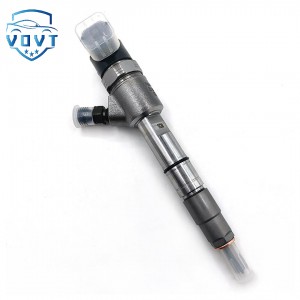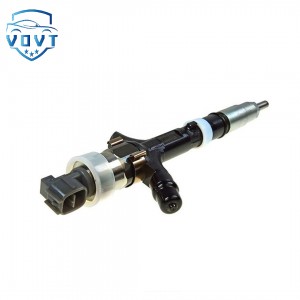Made in China Good Quality 23600-19075 Diesel Fuel Injector Common Rail Injector Engine Parts
products description
| Reference. Codes | 23600-19075 |
| Application | / |
| MOQ | 4PCS |
| Certification | ISO9001 |
| Place of Origin | China |
| Packaging | Neutral packing |
| Quality Control | 100% tested before shipment |
| Lead time | 7~10 working days |
| Payment | T/T, L/C, Paypal, Western Union, MoneyGram or as your requirement |
Introduction of fuel injector
The injector is the terminal actuator of the fuel injection system. Its function is to spray the fuel into the combustion chamber or intake manifold with precise pressure, flow and atomization state according to the engine control signal. The following is an introduction from the structure, principle, type and key parameters:
Core structure and working principle
The basic structure of the injector consists of electromagnetic components, valve body and injection components:
Electromagnetic drive part:
When the electromagnetic coil is energized, it generates a magnetic field, attracts the armature to drive the needle valve upward, and the fuel is sprayed through the valve hole; when the power is off, the spring resets the needle valve and cuts off the oil circuit.
Precision valve body assembly:
The needle valve and the valve seat are matched with micron-level precision (gap ≤5μm), and the valve seat cone is ground to ensure sealing; some injectors have a pressure chamber on the top of the needle valve to optimize fuel atomization.
Injection hole design:
Hole-type injectors usually have 1-12 injection holes (diameter 0.1-0.3mm), and the spray angle is adjustable from 60° to 150°; the pintle of the pintle injector extends out of the injection hole to form an annular injection gap, which is suitable for pre-combustion chamber diesel engines.
Types and application scenarios
According to the injection method and structural differences, injectors are mainly divided into three categories:
Electromagnetic injectors (mainstream of automotive electronic injection systems):
According to the structure:
Top inlet type: fuel enters from the top, suitable for multi-point electronic injection (MPI), response time 1-3ms;
Bottom inlet type: fuel enters from the side, the needle valve stroke is shorter, suitable for direct injection (GDI), and the injection pressure can reach 20-35MPa.
Piezoelectric injectors (high-end diesel engines/gasoline engines):
The piezoelectric crystal is energized to deform and drive the needle valve, with a response time of < 1ms, and multiple injections can be achieved (such as 5 injections per cycle), and the spray particle size is ≤5μm.
Mechanical injector (traditional diesel engine):
The needle valve is directly pushed open by the high fuel pressure (opening pressure 10-25MPa), relying on the camshaft to drive the oil pump, the spray accuracy is low, and it is gradually replaced by the electronic injection system.
Key performance parameters and technical indicators
Injection pressure:
Electronic injection gasoline engine: 2-5MPa (MPI), 5-35MPa (GDI);
Diesel engine: 100-250MPa (common rail system), the higher the pressure, the finer the atomization.
Flow characteristics:
Rated flow (such as 200cc/min@3bar), needs to match the engine displacement; flow linearity affects the air-fuel ratio control accuracy.
Response time:
Opening delay ≤1ms, closing delay ≤0.5ms, to ensure accurate injection timing (such as diesel engine injection advance angle error ≤0.5°CA).
Typical applications and technology trends
In the automotive field, injectors are developing towards "high pressure, intelligence, and low pollution":
GDI injectors: Through multi-hole injection (such as 7 holes) and conical spray, stratified combustion is achieved, reducing fuel consumption by 15%;
Common rail diesel injectors: With a high-pressure oil pump of more than 200MPa, the spray particle size is ≤10μm, and nitrogen oxide (NOx) emissions are reduced by 30%;
Integration of electronic fuel injection system: Some injectors integrate pressure sensors and temperature sensors to provide real-time feedback on injection status and improve control accuracy.
The precision of the injector directly affects the power, economy, and emission performance of the engine. Its evolution from mechanical drive to electric-hydraulic-magnetic coupling drive reflects the continuous breakthrough of fuel injection technology towards "precision control".
Related products
| 1 | 5WS40200 | 11 | A2C59514909/ | 21 | 31336585 |
| 2 | FA2C53252642 | 12 | A2C59511602 | 22 | 36001726 |
| 3 | 1685796 | 13 | A2C59513556 | 23 | 1709667 |
| 4 | 31303994 | 14 | 5ws40677 | 24 | 36001727 |
| 5 | 50274V05 | 15 | 50274V0 | 25 | 9445R |
| 6 | 5WS40087 | 16 | 5WS40677 | 26 | 00Q1T |
| 7 | 16600-00Q1T | 17 | AV6Q9F593-AB | 27 | 5WS40007 |
| 8 | 00Q0H | 18 | AV6Q9F593-AA | 28 | A2C59513997 |
| 9 | 5WS40148-Z | 19 | A2C59511606 | 29 | 5WS40250 |
| 10 | 2S6Q-9F593-AB | 20 | 16600-00Q0P | 30 | A2C59514912 |























